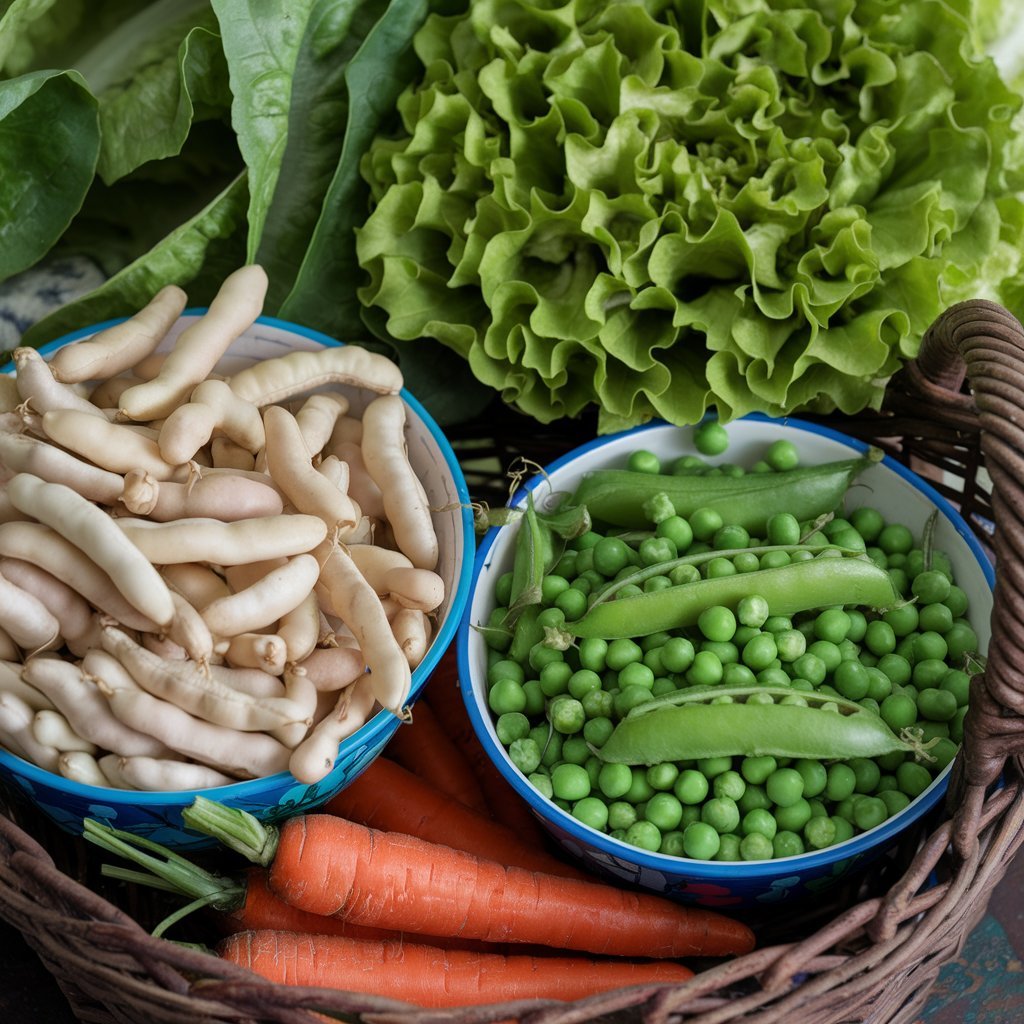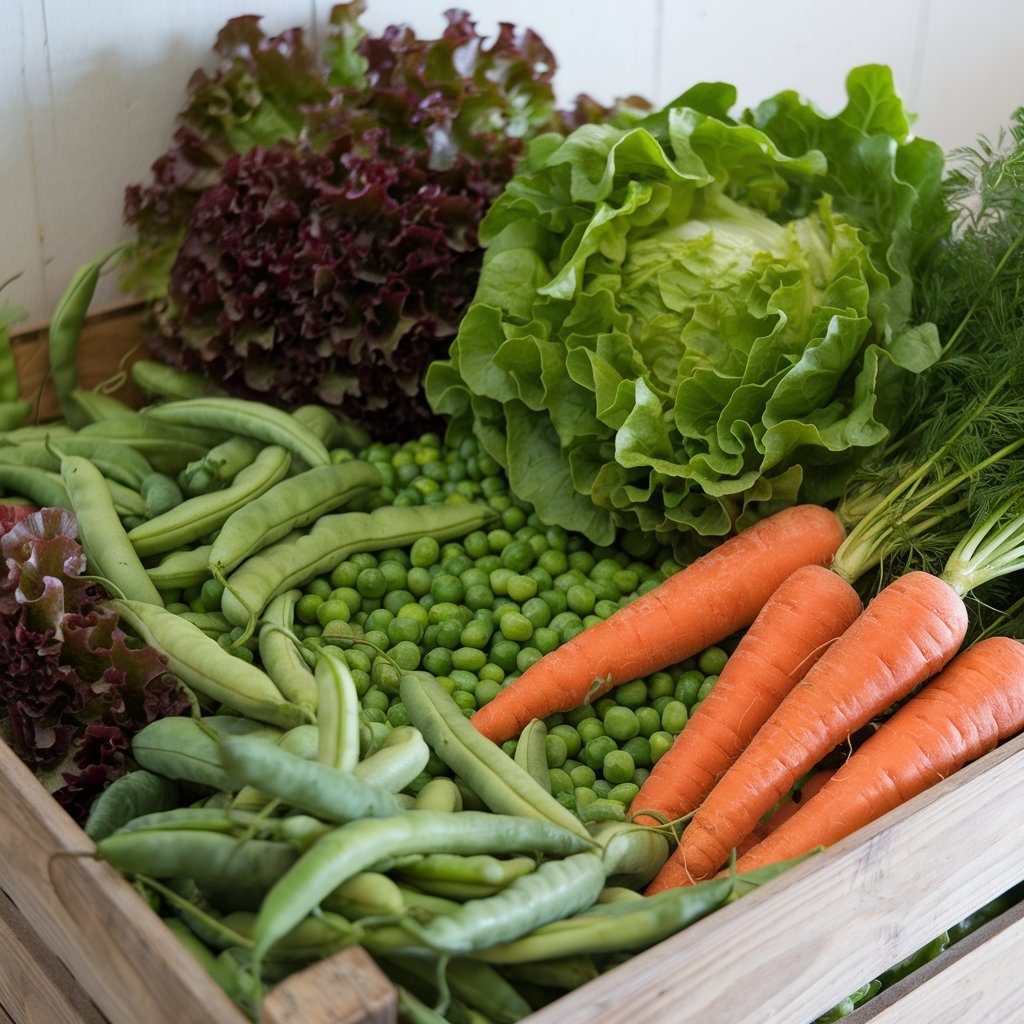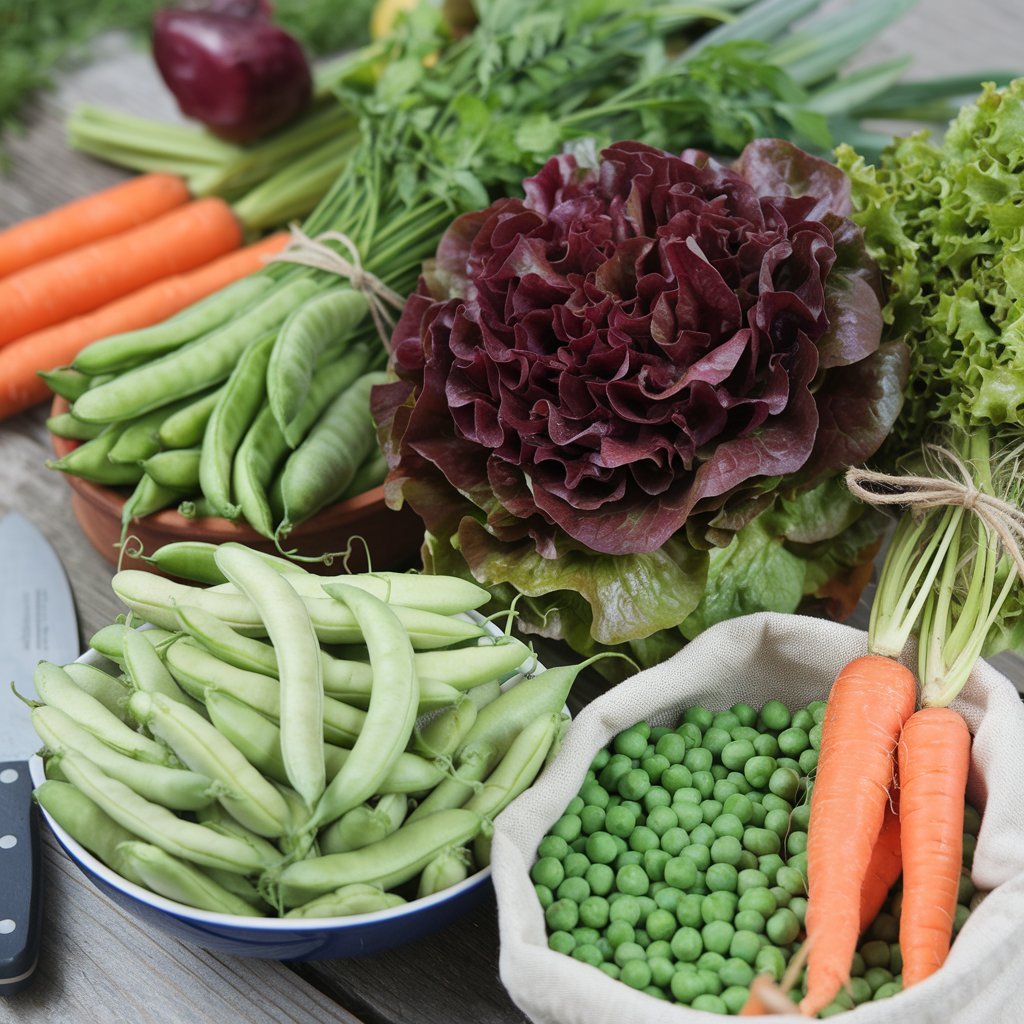Easy Veggies for Newbie Gardeners
Growing your own veggies is super rewarding, especially when you start with the easy ones. Trust me, these beginner-friendly picks make gardening a breeze.
Top 10 Veggies for Beginners
Here are my top choices for the easiest veggies to grow if you’re just getting started:
- Beans
- Lettuce
- Peas
- Carrots
- Radishes
- Herbs
- Summer Squash
- Zucchini
- Beets
- Tomatoes
These veggies are not only simple to grow but also give you a ton of fresh produce all season long. You can start them all from seeds right in the soil, which is perfect for beginners.
Planting Seeds Directly
Planting seeds directly into the soil is super easy and skips the whole transplanting hassle. Here are some tips:
- Prep the Soil: Make sure it’s well-drained and full of organic goodies.
- Plant at the Right Depth: Follow the seed packet for how deep to plant.
- Water Regularly: Keep the soil moist but not soaked.
- Thin Out Seedlings: Once they sprout, thin them out so they have room to grow.
Here’s a handy table for planting depth and spacing:
| Vegetable | Planting Depth (inches) | Row Spacing (inches) |
|---|---|---|
| Beans | 1 | 18 |
| Lettuce | 1/4 | 12 |
| Peas | 1 | 24 |
| Carrots | 1/4 | 16 |
| Radishes | 1/2 | 12 |
| Herbs | 1/4 | 12 |
| Summer Squash | 1 | 36 |
| Zucchini | 1 | 36 |
| Beets | 1/2 | 18 |
| Tomatoes | 1/4 | 24 |

These tips will get you started on your veggie garden. For more low-maintenance garden ideas, check out our low-maintenance gardens page.
Adding flowers like marigolds to your garden is a smart move. They keep pests away, attract pollinators, and add some color. Companion planting with marigolds can make your garden thrive (Almanac). For more tips on creating a simple and productive garden, visit our easy garden ideas and simple garden design pages.
Happy gardening! 🌱
Planning Your Garden
Starting Small
When I first jumped into gardening, I quickly learned that starting small was the way to go. Instead of biting off more than I could chew with a huge plot, I began with a tiny, manageable space. Trust me, it’s way less stressful and way more fun.
Here’s a quick look at why smaller is better:
| Garden Size | Maintenance Level | Success Rate |
|---|---|---|
| Small | Low | High |
| Medium | Moderate | Moderate |
| Large | High | Low |
With a small garden, I could give each plant the TLC it needed. I tried out different easy-to-grow veggies and got the hang of things without feeling like I was drowning in weeds and chores.
Companion Planting with Marigolds
One of the coolest tricks I picked up was planting marigolds alongside my veggies. These little beauties aren’t just eye candy—they’re garden superheroes. They keep pests at bay, attract helpful pollinators, and add a pop of color.
Here’s why marigolds rock:
- Pest Control: They give off a scent that bugs hate, so your veggies stay safe.
- Pollinator Attraction: Bees and other pollinators love them, which means better growth for your plants.
- Aesthetic Appeal: They make your garden look like a million bucks.
For instance, when I planted marigolds next to my tomatoes and cucumbers, I saw fewer pests and more bees buzzing around. My plants thrived, and I had a bumper crop.
To get the most out of companion planting, I checked out some simple garden design ideas. These plans showed me where to place each plant so they all got along and grew well together.
If you’re new to gardening, give marigolds a shot. They’re easy to grow and make a huge difference. For more easy garden hacks and tips, explore other sections of our site. Happy gardening!
Rock Your Garden Layout
Getting your garden layout right is like hitting the jackpot for growing easy-to-grow garden vegetables. Whether you’re a newbie or a seasoned green thumb, a solid plan can make all the difference.
Family Garden Plan
When I first dipped my toes into gardening, having a detailed plan was a game-changer. A family garden plan is perfect for beginners, featuring common easy-to-grow veggies and companion planting techniques with roomy paths. This setup makes it a breeze to move around and tend to your plants.
Here’s a sample family garden plan inspired by the Old Farmer’s Almanac:
| Section | Plant | Companion Plant |
|---|---|---|
| 1 | Tomatoes | Basil, Marigolds |
| 2 | Cucumbers | Radishes, Marigolds |
| 3 | Carrots | Onions, Marigolds |
| 4 | Lettuce | Chives, Marigolds |
Marigolds not only add a pop of color but also keep pests at bay and attract pollinators. Companion planting, like putting tomatoes next to basil and marigolds, boosts plant health and yield (Almanac). For more on companion planting, check out easy garden hacks.
Online Garden Planning Tool
If you’re like me and love a techy twist, an online garden planning tool is your new best friend. The Old Farmer’s Almanac has a fantastic tool that helps you design your garden layout. You can draw your garden plan, pick your favorite veggies, and figure out the right spacing for each plant.
Features of the Online Garden Planning Tool:
- Draw Your Garden Plan: Create a visual layout of your garden.
- Select Preferred Vegetables: Choose from a variety of easy-to-grow veggies.
- Calculate Proper Spacing: Make sure each plant has enough room to thrive.
- Information on Frost Dates: Plan your planting schedule like a pro.
- Companion Plants: Get tips on which plants grow well together.
Using this tool, I mapped out my garden and made smart choices about plant placement. It simplifies the planning process, making it easy for beginners to create a well-organized and productive garden. For more tips on creating a low-maintenance garden, visit low-maintenance gardens.
With a solid plan and the right tools, you can set up a garden that’s not only beautiful but also bountiful. Happy gardening!
Sunlight Needs for Your Veggies
Getting the sunlight right for your veggies is like giving them a VIP pass to grow big and strong. Different plants have different needs, and knowing how much sun to give them can make all the difference.
How Much Sun Do They Need?
Every veggie needs some sun, but none will thrive in total darkness. Here’s the lowdown on different sunlight categories:
- Full Sun: 6+ hours of direct sunlight. This can be all at once or split up during the day.
- Partial Sun: 4-6 hours of direct sunlight, usually in the morning or afternoon.
- Partial Shade: 2-4 hours of direct sunlight.
- Shade: Less than 2 hours of direct sunlight.
Here’s a handy table to keep it straight:
| Sunlight Type | Hours of Sunlight |
|---|---|
| Full Sun | 6+ hours |
| Partial Sun | 4-6 hours |
| Partial Shade | 2-4 hours |
| Shade | < 2 hours |

Veggies like tomatoes, peppers, and eggplants love full sun. But some, like spinach and chard, are cool with less light (Local Food Connect).
Full Sun vs. Partial Shade
Knowing the difference between full sun and partial shade is key for planning your garden. Fruiting veggies like tomatoes, cucumbers, and squash need at least six hours of direct sunlight to produce well.
On the flip side, partial shade is perfect for veggies that don’t need as much light. Think dark leafy greens like spinach and herbs like basil and parsley. They’ll do just fine with a bit less sun (Local Food Connect).
Here’s a quick comparison:
| Vegetable | Sunlight Requirement |
|---|---|
| Tomatoes | Full Sun |
| Peppers | Full Sun |
| Cucumbers | Full Sun |
| Spinach | Partial Shade |
| Basil | Partial Shade |
| Parsley | Partial Shade |
If you’re into low-maintenance gardens or easy garden ideas, knowing these sunlight needs is crucial. It helps you plant the right veggies in the right spots, making your gardening life a whole lot easier.
For more tips and tricks, check out our articles on simple garden design and easy garden hacks.
Growing Your Own Veggies: Tips for Cucumbers and Soil Prep
Growing your own veggies is like hitting the jackpot, especially when you know what each plant needs. Let’s dive into some tips for growing cucumbers and why soil prep and pH levels matter.
Growing Cucumbers
Cucumbers are a breeze to grow and can add a lot of joy to your garden. They love warm weather and need plenty of water to give you those crisp, refreshing fruits we all crave.
Types of Cucumbers
Cucumbers come in two main types: vining and bush.
- Vining Cucumbers: These guys produce more fruit over the season and are great for bigger gardens.
- Bush Cucumbers: Perfect for containers and small gardens. Planting several crops two weeks apart can boost your yield (Bonnie Plants).
Planting Guide
- Soil Temperature: Plant cucumbers when the soil is consistently around 70 degrees, at least two weeks after the last frost (Bonnie Plants).
- Spacing: Space seedlings 36 to 60 inches apart, depending on the variety (Bonnie Plants).
Care Tips
- Watering: Keep the soil moist with about an inch of water per week, especially when it’s hot. Not enough water can lead to weird-shaped or bad-tasting cucumbers (Bonnie Plants).
- Sunlight: Cucumbers need full sun to thrive.
Soil Prep and pH Levels
The secret to a killer vegetable garden is well-prepped soil with the right pH. Here’s how to get your soil ready for cucumbers.
Soil pH
Cucumbers like warm, fertile soil with a pH of 6.0 to 6.8. They can handle slightly more alkaline soil up to 7.6 (Bonnie Plants).
| Soil Type | Ideal pH Range |
|---|---|
| Cucumber Soil | 6.0 – 6.8 (up to 7.6) |
Soil Preparation
To set the stage for a big harvest, mix several inches of aged compost into the top few inches of your garden soil. Products like Miracle-Gro® Performance Organics® All Purpose In-Ground Soil can make a big difference (Bonnie Plants).
- Compost: Packs the soil with essential nutrients.
- Soil Consistency: Helps retain moisture and provides a stable root environment.
For more tips and easy garden ideas, check out other sections of our blog. Whether you’re planning a low-maintenance garden or looking for simple garden design, we’ve got plenty of advice to help you grow a thriving vegetable garden.
Quick Growing Vegetables
Want to munch on your homegrown veggies without the long wait? Let’s talk about some speedy growers that’ll have you enjoying fresh produce in no time. I’ll share some tips on how to get these fast-harvest veggies into your garden and onto your plate.
Harvest Times
Some veggies are like the sprinters of the garden world—they’re ready to eat in just a few weeks. Check out these quick growers:
| Vegetable | Harvest Time |
|---|---|
| Radishes | 3-8 weeks |
| Baby Carrots | 5-6 weeks |
| Cucumbers | 7-8 weeks |
| Spinach | 4-8 weeks |
| Green Onions | 3-4 weeks |
These veggies not only grow fast but also add a burst of flavor to your meals. Radishes are great for salads, spinach can be picked within a month, and cucumbers are perfect for snacking or pickling.
Getting the Most Out of Quick Harvests
To make the most of these speedy veggies, try these tips for a hassle-free garden:
- Succession Planting: Plant veggies like radishes and spinach in stages. This way, you’ll have a steady supply all season long.
- Companion Planting: Pair quick growers with slower ones. For example, plant baby carrots next to marigolds. This not only saves space but also helps your garden thrive.
- Raised Beds: Use raised beds for faster soil warming and better drainage. This speeds up growth and makes harvesting a breeze.
- Regular Harvesting: Pick veggies as soon as they’re ready. This encourages more growth and extends your harvest period.
For more tips on creating an easy-to-manage garden, check out our guides on simple garden design and easy garden hacks. With these practices, you’ll be enjoying a quick and plentiful harvest from your garden in no time.

My name is Michelle Warren, and I’m the founder of Peaceful Gardening. As a 10-year breast cancer survivor, I’ve discovered the profound therapeutic power of gardening. This journey has not only helped me recover but has also become my passion and a source of ongoing peace and joy.
Peaceful Gardening was born from my desire to share the healing benefits of gardening with others. Whether you’re facing health challenges, dealing with stress, or simply looking to connect more deeply with nature, this space is for you.
Over the past decade, I’ve cultivated not just plants, but a deep understanding of how gardening can positively impact mental health. I’ve worked with local community gardens, led workshops on mindful gardening practices, and collaborated with mental health professionals to develop gardening-based stress reduction programs.
Peaceful Gardening was born from my desire to share the healing benefits of gardening with others. Whether you’re facing health challenges, dealing with stress, or simply looking to connect more deeply with nature, this space is for you.
Here, you’ll find evidence-based advice on using gardening as a tool for mindfulness, stress relief, and emotional healing. I share personal stories, practical tips, and scientifically-backed information on how to create your own therapeutic garden space, no matter the size of your yard or balcony.
My mission is to help you discover the joy, peace, and healing that comes from nurturing plants and connecting with nature. Join me in exploring how the simple act of tending to a garden can transform your mental and emotional wellbeing.
Welcome to Peaceful Gardening – let’s grow together towards better mental health!”

